The new cross-London railway, the Elizabeth Line, is launched on Tuesday, 24th May. It will stop at 41 accessible stations, 10 newly built and 31 upgraded, and is expected to serve about 200 million people each year. The east-west line will link Reading and Heathrow in the west with Shenfield and Abbey Wood in the east via twin tunnels between Paddington and Whitechapel.
At this moment of ambitious expansion, we've taken a look at the evolution of underground etiquette, and shared some handy tips for the modern tube traveller.
London’s underground adventure began in 1863, when the Metropolitan railway began to convey passengers from Paddington to Farringdon beneath London’s congested streets. The first trains were steam-powered and, while early travellers were astonished by the speed of travel, the smoky underground atmosphere sent many passengers coughing and spluttering to a pharmacist near Euston, where they could procure glasses of ‘Metropolitan Mixture’, guaranteed to soothe irritated throats and lungs. An American visitor to London, R. D. Blumenthal, described the early underground experience: “The atmosphere was a mixture of sulphur, coal dust and foul fumes from the oil lamp above; so that by the time we reached Moorgate Street I was near dead of asphyxiation and heat.”
The electrified City & South London Railway opened in 1890, the first deep-level “tube” in the world. Initially there were no windows (the engineers reasoned there was nothing to see), but they soon discovered that passengers were dubbing the wondrous new system “the sardine box railway” and windows were eventually added.
The arrival of the tube heralded great changes in society, reflected in new manners and etiquette. The underground facilitated the movement of unchaperoned women around the city, and this caused many social challenges. People of all classes and backgrounds were forced into close proximity in crowded stations.
Initially, underground carriages were categorised into first, second and third classes, with first class passengers enjoying spacious padded seats and carpets, while third class carriages offered wooden benches. Signs on platforms indicated where passengers should wait for their correct class carriage, but it soon became apparent that distinctions were being ignored in the great rush to board. A female writer in The Queen journal complained that overcrowding forced “ladies living in the country to travel with men in soiled garments, covered with clay or brick or rubbish, or reeking with odours of stale fish”. In 1900 the class distinctions were abandoned.
Initially smoking was not allowed on the underground, but this stricture was soon overturned, and by 1870 smoking carriages were allowed. These had to be provided for each class of travel, and in some cases were reserved for men. It was argued that smoking was bad for women’s health, and the habit of smoking in carriages in the presence of ladies was roundly condemned.
However, ladies had other ideas. When ‘ladies only’ carriages were introduced, which were free from tobacco smoke and the possibility of unwanted male attention, ladies voted with their feet and opted to choose their own carriages, resisting attempts to segregate them. Ladies only carriages, which were always empty, were eventually discarded. It was a tenet of Victorian etiquette that gentlemen gave up their seat for ladies. If they did so, ladies were recommended to accept graciously, either thanking him or bowing, but refraining from smiling at the stranger, and limiting herself to a “grave but cordial thank you” (Sensible Etiquette, Mrs H.O Ward, 1878).
With nothing to look at outside the windows, there was an issue on underground trains about how people would entertain themselves during the journey. Reading newspapers was an enduringly popular way of remaining cocooned from the rigours of tube travel, and when advertising began to make an appearance in carriages passengers found it diverting. There was, of course, always the risk that a passenger would catch a fellow-traveller’s eye, causing social embarrassment, or that male passengers would stare insolently and appraisingly at ladies. The Ladies’ Book of Etiquette (1875) advised ladies to “lower your veil and turn from him”, reassuring its readers that “a dignified modest reserve is the surest way to repel impertinence” and insisting that “nothing will rebuke incivility in another so surely as perfect courtesy in your own manner”.
Trains were inordinately loud, making conversations impossible. The prevailing tendency was to mind your own business, immuring yourself in your own unreachable and self-contained zone, a behaviour that is still very recognisable today.
The introduction of escalators into crowded stations in 1911 introduced new challenges to tube passengers. Initially, guards instructed passengers to walk up the escalators, treating them as moving staircases. Gradually, underground workers introduced a system where those who wanted to stand still could do so on the right-hand side, while people who walked up the escalator used the left-hand side. This system is still in place today.
The congestion of the London underground, the huge numbers of passengers, and complexity of the route system, were all challenges that were addressed by the railway authorities, who began to issue a series of innovative instructional posters, which were intended to initiate their users in the correct underground etiquette. The posters focused on social conduct and ways of ensuring the journey was as pleasant as possible: they advised how to enter a crowded carriage; warned against blocking the doorways; pleaded with people on the platform to let passengers off first; recommended moving down the platform to reduce overcrowding – all these instructions can still be heard today.
Often the messages were framed in a moralistic tone, stressing the fact that ‘good’ tube behaviour was considerate towards other people. A 1918 poster instructed passengers to move down inside the carriage because “everyone cannot get a seat at the busy hours but more could get a strap or standing room if the doors were left free from the crush. Think of others. A door obstructer is a selfish person.”
In 1927 a poster outlined a paradigm of underground virtue. Headed “A Fair Average Conduct Helps the Service” it is the account of an archetypal passenger’s considerate, if predictable, journey: “I entered the Tube Station and took my place in the queue, I had the exact fare ready, I passed across the lift, I stood clear of the gates, I bewared of pickpockets, I passed down to the other end of the platform, I let them off the car first, I stepped on quickly, I passed right down inside, I passed out quickly, I stood on the right of the escalator, I allowed others to pass, I stepped off with the right foot, I had my ticket ready, I emerged by the “Exit Only,” I walked smartly to the office. Why? Because I do it every day. Why? Because I’m, unfortunately, that sort of chap.”
Underground Etiquette for Modern Travellers
• Be prepared when you enter the underground station, and have your Oyster card, debit card or phone ready to place on the reader. Especially in rush hours, the flow of passengers through the entrance gate is fast and relentless, and people will be annoyed if you hold them up.
• If you want to stand still on the escalators, stick to the right-hand side, allowing people to walk up and down on the left hand side.
• Once you arrive at the platform, move along so that you are not blocking entrances and exits.
• When the train arrives, stand to one side of the opening doors and allow passengers to disembark. Do not jostle or barge into other passengers in your eagerness to board – another train will be along very shortly.
• Once on board the train, move down inside the carriage – there are plenty of handles and rails to assist you. Do not bunch up in the entrances near the doors as it will make it difficult for passengers to disembark.
• The carriages can be quite crowded so try not to take up excess room with your luggage and possessions. If you are wearing a backpack, be aware that there is a protuberance on your back that could inconvenience other passengers – it is best to remove it before boarding.
• In summer the tube can get uncomfortably hot, so travel with a bottle of water and remove your coat before boarding.
• Only use one seat – do not dump your possessions on the vacant seat next to you.
• Do not occupy more than your allocated space by slouching or sprawling in your seat or man-spreading.
• If you are listening to music or podcasts, use headphones or earbuds. Loud music leaching out of your headphones will be frowned upon – tubes are conventionally quiet spaces.
• Minimise eating and drinking on the tube. Lurching trains and sudden stops can easily lead to embarrassing spillages and smelly foods can be overpowering in a confined space.
• Do not stare at your fellow passengers. If you find yourself without the distraction of your phone, or a book or newspaper, try to fix your gaze above the opposite passengers’ heads, where you adverts, tube maps, and possibly even poetry will distract you.
• It is important that you respect the Priority Seat signs. In any case, if you see an elderly person, or someone who is pregnant, or a mother with a small child in tow, it is a considerate gesture to offer them your seat.
• If you are offered a seat, graciously accept it, even if you do not feel that you actually need it. If you are only staying on the train for a couple of stops, say so and politely refuse.
The summer season at Glyndebourne begins every May. Glyndebourne, which presents six operas from May to August every year, is the archetypal country house opera venue. It hosts one of handful of world-famous English summer opera festivals, which include The Grange, Grange Park and Garsington.
Country house opera represents a typically British attitude to the summer. There is a recognition of the unique beauty of manicured British gardens, picturesque and historic country estates, and summer views across glorious countryside. There is also a robust refusal to countenance the vagaries of the British summer – each of these festivals is built around an optimistic desire to indulge in long twilight champagne picnics in glamorous evening dress – a magical experience that can be severely hampered by rain and chilly evenings. Despite the risks of rain ruining al fresco dining, the opera performances are viewed with the utmost seriousness, and each location has a dedicated permanent opera house, which ensure that the performances are never disrupted by the summer weather. Indeed, each of these opera festivals is a renowned forum for world-class music.
Dating back more than 80 years, Glyndebourne opera attracts thousands of opera-lovers from London and further afield, especially for its Mozart, Handel and Janácek, staged in the acoustically brilliant, modern auditorium that opened in 1994.
Landowner John Christie, who inherited the historic country house (probably 16th-century), and his opera-singer wife Audrey Mildmay originally set up the festival as a showcase for small-scale productions of Mozart operas in 1934.
Encouraged by his wife (“If you’re going to spend all that money, John, for God’s sake do the thing properly!”), John Christie created an auditorium that could seat 300, and launched his first opera season with a repertory that initially focused almost exclusively on the works of Mozart, before gradually expanding to include operas by Britten, Verdi, Rossini, Handel and many others.
From the outset, the standard of operatic performance was unimpeachably high, and opera-lovers were gratified by the beauty of the downland setting and the exquisite gardens, both of which could be enjoyed during the long interval breaks. Far from being a rich man’s folly, Glyndebourne rapidly became a much-admired international institution.
By the 1990s it was clear that Glyndebourne needed an even larger auditorium so in 1994 a new multi-million pound opera house was built to seat 1,200, opening with a performance of Mozart's Le nozze di Figaro, a fitting tribute to the Festival’s origins.
Performances commence in the late afternoon and are punctuated by a lengthy 90-minute interval during which dinner can be taken on the extensive lawns, in the form of a picnic, or in one of the restaurants within the grounds. The operas all finish between 9.30–10pm, allowing opera-goers plenty of time to return to London by train from Lewes station. There is a ten, five and three-minute warning bell before curtain–up and at the end of the long interval. Latecomers are not admitted into the auditorium.

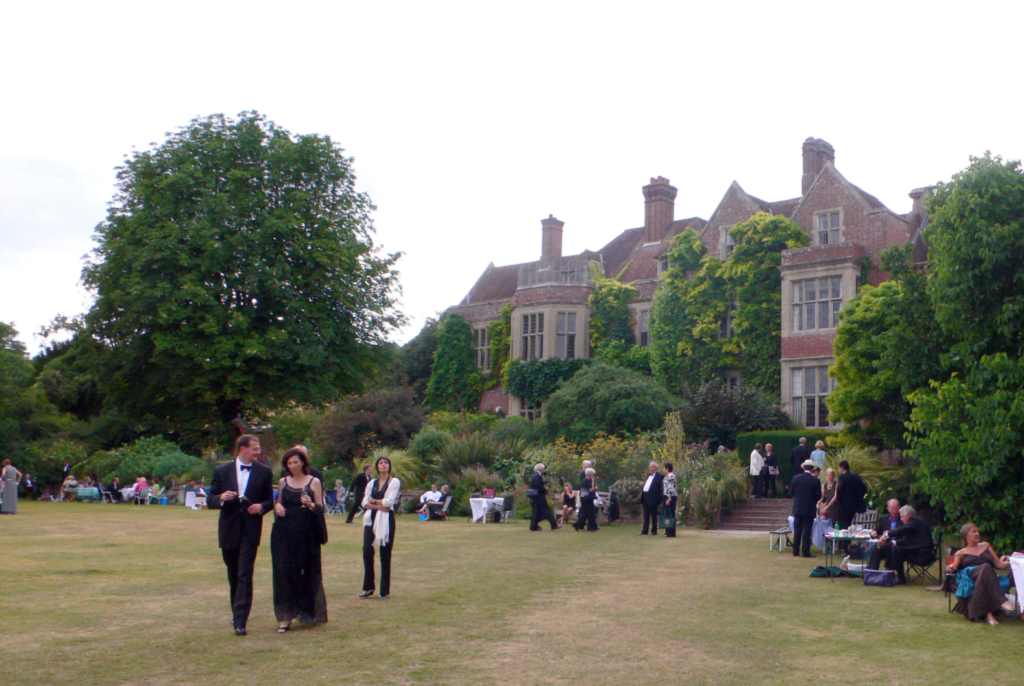
Dress Code
Evening dress (dinner jackets) is customary but not compulsory. There are changing facilities in the Plashett Building at the foot of the car park. It is advisable to bring a shawl, wrap or pashmina, as rural English summer evenings can be very chilly. Ladies may do well to devise evening outfits that include lightweight summer coats to ward off the chill.
Although there is no formal dress code, jeans, trainers, shorts and flip-flops will be frowned upon.
Traditional Picnics
There is a tradition at Glyndebourne of picnicking in the gardens, and most visitors choose to do this. It is customary to set up before the performance – and enjoy a glass or two with a canapé – ready to start the picnic dinner in the 90-minute interval. Arrive early to secure a good spot in the gardens; if it is windy, make sure everything is well-battened down. Picnic rugs are easiest to transport to and from the car but more formally dressed opera-goers will probably prefer the decorum of lightweight folding tables and chairs.
If the weather looks changeable, grab an undercover spot in the covered balconies of the Circle and Upper Circle levels, or in the marquee next to the Archive Gallery.
Glyndebourne is a special occasion, and opera-goers reflect the spirit of the evening with reasonably grand picnics. British summer classics, such as smoked salmon, asparagus and strawberries, are popular choices; real cutlery, linen napkins and glasses are the norm, along with a bottle of chilled bubbly. Awnings and gazebos are not permitted.
It is sensible to pack-up picnicware before the end of the long interval and leave it near the auditorium, allowing for a speedy exit at the end of the performance. Make sure you include a bag for your rubbish.
Opera Etiquette
• Arrive on time; most opera houses won’t let you in after the opera has begun and you will have to wait until the interval for admittance.
• Don’t ruin the drama by whispering, coughing or rustling sweet papers.
• Ensure that your mobile is turned off during the performance – ringing tones during a famous aria are a capital offence!
• It is customary to applaud only when the conductor takes to the podium, after the overture, at the end of an act, after an impressive aria and at the final bows.
• ‘Bravo’ is shouted during the applause; ‘bravo’ is exclaimed for a male performer and ‘brava’ for a female performer.
• Surtitles, also called ‘supertitles’, provide an electronic rolling text of a summary translation above the stage to help the audience keep up with the plot.
Gossiping is universal. Throughout history, gossip has been a human survival tool, an excellent way of communicating opportunities and dangers. Gossip is also an invaluable way of establishing social norms of behaviour – discussing our fellow humans’ behaviour gives us insights into what is socially acceptable and what is considered beyond the pale.
At its most basic definition, gossip is talking about someone who isn’t present, and that of course is not inevitably negative. Humans are impelled to share information about each other – perhaps they need to alert a group to a mutual friend’s predicament, or spread good news about a birth, marriage, or new job.
Gossiping is undeniably enjoyable – for many people it is an effective way of forming bonds with a group, especially when people are thrown together in the workplace and are outside their normal comfort zone of friends and family. Discreetly handled, gossip can also be a good way of letting off steam and venting aggression, without ever venturing into real conflict or confrontation.
But this essentially benign chit-chat seems a long way from the thrill of betraying confidences and relaying other people’s secrets or spreading unsubstantiated rumours, and enjoying the frisson of turning speculation into fact and watching it spread like wildfire through your social network, accumulating new twists and turns as it goes. This process has given gossip a bad name, and to call someone a ‘real gossip’ is to condemn them for being indiscreet and salacious.
The main perpetrators of gossip may see their never-ending fount of rumours and speculations as a fast track to popularity – other people will always be keen to listen, and they may well mistake a malicious hunger for new rumour-mill fodder as social endorsement.
However, rumours are about real people, who may feel they are being maligned and persecuted. Confidences are betrayed, facts are twisted, reputations are damaged. At its worst, gossip can feel like a targeted act of aggression, designed to be exquisitely humiliating and shaming, and can cause very real distress to the victim. Professionally, malicious gossip can do real harm, altering colleagues’ perceptions of the victim’s honesty, probity and conduct. This insidious poison is very hard to pin down; victims may be only dimly aware of the source of their distress, and unable to find ways of preventing it.
Needless to say, social media has vastly exaggerated the negative impact of gossip. Nowadays the most egregious rumour-mongers find themselves provided with an avid online audience, ever ready to consume and disseminate their lies to an ever-wider circle of followers. It is small wonder that the targets of this online torture feel victimised and hounded.
If you are a target of gossip you have a number of options. If you feel enough righteous indignation you can directly address the perpetrator and explain how the gossip has made you feel and the impact it has had on you. You can even do this in public for maximum effect. For many people, this confrontational approach is a step too far, and they may feel inclined to let the gossip play itself out – all gossip is transitory and once it is out there the currency is immediately devalued. The final option is to approach the gossip through the back door; identify the main culprit, then signal out some of their clique and outline the damage that has been done and the effect it has had on you. You may succeed in shaming them into silence.
If you indulge in gossip yourself, there is a risk you will be overheard spilling secrets about someone or something. If you’re gossiping digitally, you may even make the fatal error of sending a message to the wrong person, or including them in an incriminating chat. Clearly, the right thing to do in these circumstances is to immediately acknowledge the fault and apologise, though this option is not for the faint-hearted. A more insidious choice is to bluff it out and pretend you never knew the information you were spreading was top-secret or incriminating.
Bearing all this in mind, remember the old adage “If you have nothing nice to say, don’t say anything at all.” It is unlikely that many of us will be able to adhere to this advice all the time, but it is good to keep it in mind when a juicy nugget of gossip comes our way.
The Order of Precedence in the UK is the long-established hierarchy of members of the royal family, clergy, peers of the realm, officers of state, holders of Crown honours, and professionals that underpins British society. It has existed for centuries, and long been formalised into Tables of Precedence, which are used when planning formal events, such as state banquets, guild dinners and diplomatic functions. The simple idea is that a person’s status in society is always acknowledged, and that status is reflected in table plans, formal lists of names and so on.
In the past, the Tables of Precedence were rigidly observed, leading to many anomalous situations where an inherited title or marital status automatically trumped age and experience. Whereas in some situations social rank may still be deemed to be of the utmost importance, at the majority of functions nowadays considerations such as professional status and age are now treated as equally determining factors. The nature of the occasion provides the most telling guide and should offer indications as to the relative significance of guests. Clearly, a guest of honour must be seated so as to reflect his or her status, and, by way of example, the chairman of a host company, the MP of the constituency in which a function is held, a foreign dignitary whose country is being honoured, or a benefactor at a charitable event should all be recognised and seated appropriately.
Royal Guests
The Sovereign of the United Kingdom is always first in the Order of Precedence and there are clear guidelines to be observed when The Queen or a member of the royal family is to attend an official function. Efficient liaison between the host’s office and Buckingham Palace is essential.
The precedence of all others is the Sovereign’s prerogative. Even the precedence of those who appear in the official Tables of Precedence varies from time to time. Moreover, it not infrequently happens that, in the relationship between host and guests, the requirements of courtesy and hospitality override any strict order of precedence.
Precedence: Top Table
Ministers of the Crown and Privy Counsellors should be placed at the top table on formal occasions. Important dignitaries of the established church are placed high among the guests. High dignitaries of other churches should, as a courtesy, be accorded status immediately after those of the same rank from the established church.
When a function takes place within premises belonging to a specific organisation, a senior representative of that organisation should be invited and placed high amongst the guests.
Ambassadors, High Commissioners and Chargés d’Affaires should be placed at the top table, their relative precedence being strictly observed (The London Diplomatic List, published at two-monthly intervals by HMSO, gives a roll of the heads of diplomatic missions in London in order of precedence).
As a general rule diplomatic representatives from countries that do not enjoy diplomatic relations with each other should not be invited to the same function. When, as sometime happens, it is necessary to invite them, care should be taken to avoid placing them near each other.
Seating Plans
The principal guest is placed on the host’s right. Traditionally the principal guest’s wife would be placed on the host’s left, the host’s wife being placed on the right of the principal guest. If wives are present, the second most important guest would be placed on the host’s left.
It is now as likely for the host, or the principal guest, to be a woman, in which case the same basic principles may be applied, with any necessary adaptations employed to achieve the desired balance.
At an official function important members of the governing body should be interspersed among the principal guests. Guests’ partners should be placed according to the precedence of the guest invited in their own right. It is up to the host to decide whether husbands and wives are to be seated together or apart. The former is easier to arrange, but the latter (which is always followed at private functions) gives both husband and wife a chance to meet new people.
The revised Highway Code, published in January 2022, makes it clear that vehicles that carry the greatest potential to do harm should be operated with a corresponding sense of caution and responsibility towards more vulnerable road users, creating a hierarchy of responsibility from huge HGVs to humble pedestrians.
The Highway Code’s new hierarchy is an explicit attempt to save us from ourselves. We have all experienced the phenomenon of a fierce sense of identification with the group to which we currently belong. If we are driving cars, we are maddened by irritating pedestrians and cyclists; if we are on foot we feel threatened and overlooked by cyclists and motorists, and so on. We are all quite capable of shifting these loyalties several times a day, depending on our circumstances. Defining and codifying our behaviour towards other road-users is an attempt to control these dangerous blindspots.
Pedestrians are now offered special protection. Not only must vehicles (including cycles) stop for them at zebra crossings, they must also give way at junctions where pedestrians are waiting to cross, or already in the process of crossing, and allow them to do so.
But pedestrians are not only protected from drivers in overbearingly large vehicles, they are also shielded from cyclists. Pavements are for pedestrians (and wheelchairs and mobility scooters) only. Cyclists are not allowed to use pavements, and it is to be hoped that, even if they are forced to share a cycle track with pedestrians, they will henceforth resist all temptations to intimidate slow-moving foot traffic: peremptory ringing of bells; sitting threateningly on a walker’s shoulder; swerving dangerously close to pedestrians as they overtake.
Inevitably, safety on the road is greatly enhanced by being observant and self-aware. Pedestrians’ vulnerabilities have been acknowledged in the new Highway Code, but it is still important that, when you are walking along a busy road, you are acutely aware of your environment – remember that looking at your phone as you walk and cutting out warning sounds by using headphones may lead to erratic, and dangerous, behaviour.
Moving up the hierarchy, cyclists need not feel discriminated against. Whilst their behaviour towards pedestrians is moderated, they are offered new protections from motorists. Horses and horse-drawn carriages are given the same rights and protections as cyclists.
When cyclists are going straight ahead at a junction, they have priority over traffic waiting to turn in or out of a side road. They are also given priority on roundabouts, where they may stay in the left-hand lane. Motorcyclists and other drivers are also advised they must not cut across cyclists when turning in or out of a junction, or changing direction or lane.
Safeguarding the vulnerable is laudable, but while the amended priorities laid out in the Highway Code provide a protective, and stratified, approach to other road-users, our actual conduct on the roads, whatever the rules we follow as we travel along them, is very much a matter of manners and behaviour.
Follow these simple rules to make our roads a more civilised and safer place for all road-users. Remember, good driving manners signal a reassuring awareness of other motorists, and an ability to disregard the vagaries of other drivers and rise above them.
• Let other cars into the queue in front of you with a friendly wave or flash of the headlights – a graceful gesture that will only cost you seconds.
• Acknowledge other motorists’ gestures – it will make crowded, frustrating roads seem infinitely more civilised.
• Indicate before you overtake or turn off. No one should have to second-guess your intentions, and sudden changes of direction endanger other road-users
• Breaking the speed limit is dangerous, but hesitant kerb-crawling can be very annoying for drivers caught behind you. Be decisive; if you are lost, pull over and consult a map or make polite enquiries of a passing pedestrian.
• Have the good sense to realise that children can be very unpredictable, and maintain extra vigilance around schools and residential areas.
• Always give cyclists and horse-riders plenty of leeway, slowing down when you approach them, and indicating when it’s safe to overtake.
• Acknowledge pedestrian crossings by slowing down as you approach them and checking for waiting pedestrians, or people who are approaching the crossing. Offer them the simple courtesy of waiting until they have finished crossing the road before you move away; never rev your engine as people are crossing the road.
Once in a car, normal manners may fly out of the window. Encased in metal, you can feel invincible, confident that other drivers will not detect your anger through the glass windows and engine noise. But a car is a potentially lethal weapon, and a good driver will always remember this before using it as a way of expressing irritation, frustration or red-blooded rage. It goes without saying, therefore, that aggressive driving should be avoided at all costs:
• Tailgating, with or without flashing headlights, and pointless horn-blowing are not the signs of alpha superiority, merely a dangerous inability to control emotions while in charge of a very powerful, and dangerous, machine.
• Do not take it upon yourself to police other drivers. We all witness bad driving every day, but the safe option is to adopt an attitude of zen-like calm and acceptance. If you feel agitated, pull over, calm down and, when you feel relaxed, continue your journey.
• Slow down and hold back if a road user pulls out into your path at a junction. Allow them to get clear. Do not over-react by driving too close behind to intimidate them.
• Avoid arguing with your passengers – it is dangerously distracting.
• Make allowances for older drivers: they may have slower reactions.
We all know a know-all – someone who believes that they possess a superior intellect and wealth of knowledge, and who shows a determination to demonstrate that superiority at every opportunity. In a world where knowledge is power, the know-alls should be ruling the planet.
Yet it seems to be one of those truisms, that the more know-all someone is, the further they are from actually running things. After all, if they knew it all, they would know that it’s the worst sort of rudeness to let everyone else hear about it. On the contrary, the get-aheads often seem unencumbered by sacks of facts. While the know-alls are relentlessly exhibiting the sum of their knowledge, the get-aheads are far too busy getting on with the job in hand to waste time pointlessly showing off.
Sometimes a know-all will stray, unknowingly, into your own area of expertise or experience, facing you with a dilemma. You can either sit back with a superior smile on your face, wait for them to get tangled in some half-understood detail, and then trip them up with a devastating display of knowledge. But that kind of social humiliation is cruel and does not reflect well on you. At the other end of spectrum, you can sit meekly, nodding assent as they mutilate your specialist subject with untruths and unsupported assertions.
It is better, inevitably, to take the middle way; as soon as you see the know-all blundering into your knowledge zone, just give them a little hint that they’re in dangerous territory, for example politely mentioning that the subject in hand is a particular passion, or something you have studied in detail, or something that you have experienced yourself. It is important that you clarify your superior knowledge and give them an escape option before they dig their own grave. If they plough on regardless, then they do so at their own peril – they have been warned.
We all love trivia, useless knowledge and the occasional weird feats of memory, but most of us have the sense to realise that it is not clever to trumpet such empty expertise. It’s fine to dredge up arcane knowledge at a dinner party if people find it intriguing or amusing, but beware – entertaining your friends with amusing trivia can all too often mutate into boring your friends with tedious irrelevancies, so watch out for the glazed eyes and stifled yawns.
If you are faced with a know-all, pity them for their lack of self-awareness, and listen intently to their verbal bludgeoning for the odd interesting fact. When you feel you’ve travelled as far as you reasonably can into the dull vistas of the know-all’s inner world, move on politely, leaving them, and their empty knowledge, behind you as you get on with real life.
• Remember that the more know-all someone is, the further they are from actually running things.
• Endless displays of empty expertise are likely to bore an audience to death, revealing only the know-all’s own feelings of self-importance.
• If you are faced with a know-all, pity their lack of self-awareness.
• If a know-all strays into your own area of expertise, subtly give them fair warning – failing to extricate themselves may have humiliating consequences.
The long weekend of 2–5 June 2022 is the occasion on which the nation celebrates the Queen’s 70-year reign. This is a very special and unique anniversary and much of the country will be marking it in some way. There are a plethora of possibilities, from traditional street parties, and the ‘Big Lunch’, to private garden parties and barbecues.
This week, in association with Party Pieces, we take a look at Jubilee entertaining.
Dating back to post-World War I ‘peace parties’, which were held in 1919, street parties have always held a special place in British hearts. They have marked national milestones, such as VE and VJ day, the Coronation, Royal weddings and Royal anniversaries.
Their defining characteristic is that they involve shutting off an entire street. This means planning in advance (six weeks is recommended) and obtaining permission from the local council, which may need to re-route traffic. Traffic cones and ‘Road Closed’ signs will be needed, which can be borrowed from local schools or the council. Or you can just block off the road with wheelie bins…
Once the road is closed, the event can take many forms. Traditionally, partygoers eat at long trestle tables, but this is not obligatory, and a stand-up buffet may be a more practical alternative. Music and party games (such as treasure hunts, tug of war, or sack races) will break the ice and add to the conviviality. Alcohol can be served without a special licence (as long as it isn’t on sale).
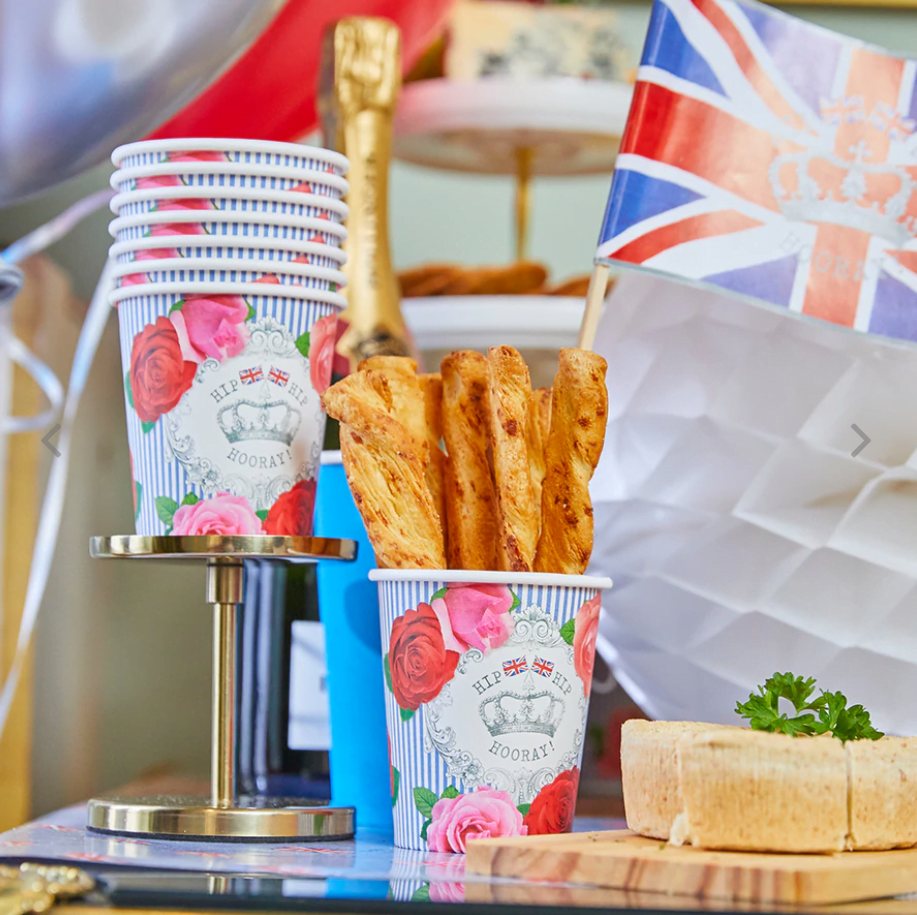
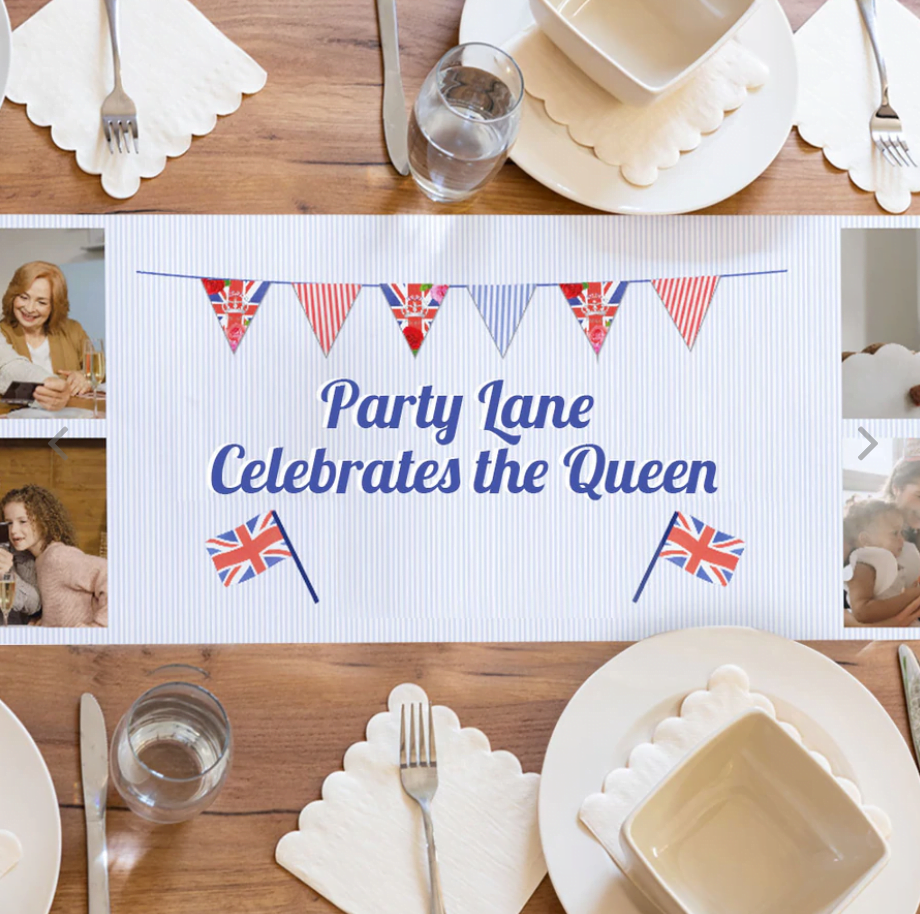
This initiative from Cornwall’s Eden Project started in 2009 as an annual opportunity for neighbours to meet up, eat together and celebrate community. It will be a major national event on Sunday 5 June. In many ways it shares the characteristics of the street party, but the venue is more flexible – it could, for example, be held on the local playing field, village green, or recreation ground. As the name implies, it involves a sit-down lunch; this is normally organised on a cooperative basis, with people contributing their own dishes (it’s a good idea to allocate sweet or savoury beforehand). In some instances, guests will simply be asked to bring their own lunch to the event – the main point is to enjoy getting to know your neighbours, not the food.
Many people will choose to celebrate the Jubilee on a more intimate scale. This may involve hosting a garden party for immediate neighbours or simply holding a Jubilee-themed barbecue or lunch for friends and family.
Whatever you choose to do, you will want to reinforce the message that this is a Jubilee event, which can be done by using themed decorations and maybe even featuring a special dish with royal associations.
One prerequisite of a Jubilee party is bunting. These colourful strings of triangular flags date back to the early seventeenth century, when the Navy used them to communicate from ship to ship. The flags were of a lightweight woollen material, called bunting. An individual flag was known as a ‘tammy’, from the French word for the fabric (estamet). This durable material was resistant to direct sunlight and held its colour well. Each flag represented a number, letter, or combination of letters, which could be hoisted on to the masts of a ship to convey messages.
Bunting has now been co-opted for decorations and celebrations of all kinds. The material no longer has to be cloth, and anything from paper to plastic can be used, though it does help if the material is lightweight enough to ensure the flags flutter in the breeze.
You can opt for classic Union Jack British bunting or you could elect to use a more subtle decoration, which blends a palette of red, white and blue, with Union Jacks and English roses.
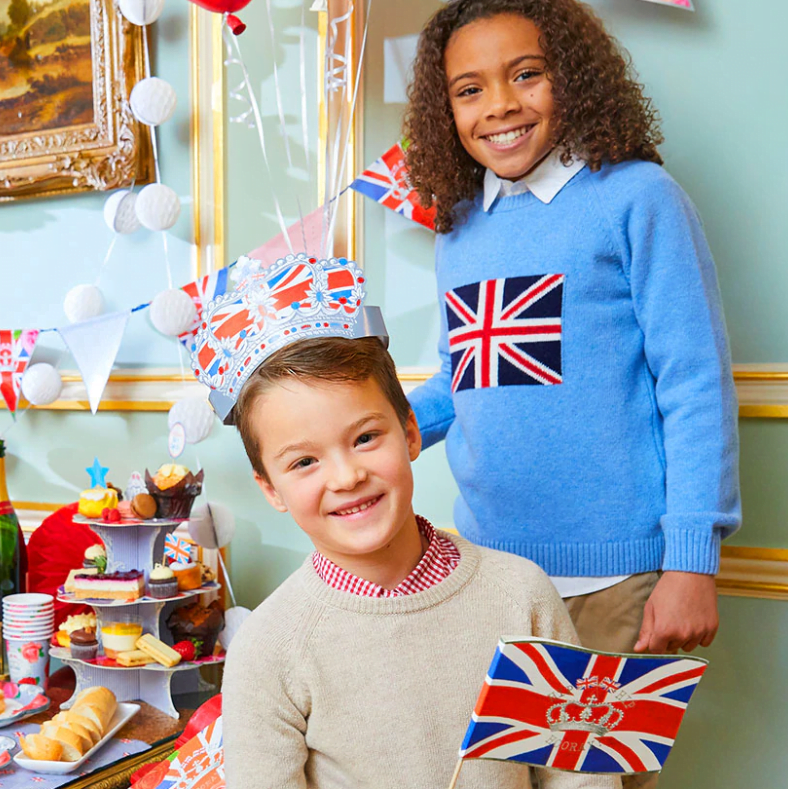

A sure-fire way of reinforcing your Jubilee theme is to decorate your tables appropriately. This doesn’t need to be particularly expensive; since you will probably be looking for disposable table decorations in any case, take the trouble to buy some special Jubilee paper tablecloths and napkins, plates and cups. Even if you are entertaining at home, and using your own crockery and glassware, Jubilee-themed paper napkins and tablecloths, as well as bunting and balloons, will all contribute to the celebratory ambience. Remember, red, white and blue is the patriotic order of the day!
Party Pieces’ eco-friendly Great British Party Collection offers a range of bunting, tableware, cake toppers and cake stands, all sporting a unique Platinum Jubilee design, which weaves together English roses, coronets and Union Jacks.
There are going to be lots of children at these events, and they will love waving their own flags, and even sporting special Jubilee party hats. Union Jack-coloured balloons will all contribute to the party atmosphere. This is a great way of keeping kids involved and happy throughout the day.
Ensure that all the disposable materials you buy are fully recyclable (look out for FSC-certified), and – particularly if you are organising a larger party – invest in plenty of large rubbish bags and recruit some volunteers to make a thorough sweep of the street and eradicate all signs of rubbish at the end of the day – you do not want to wake up the next morning and find your shrubs and lawn strewn with Jubilee detritus.
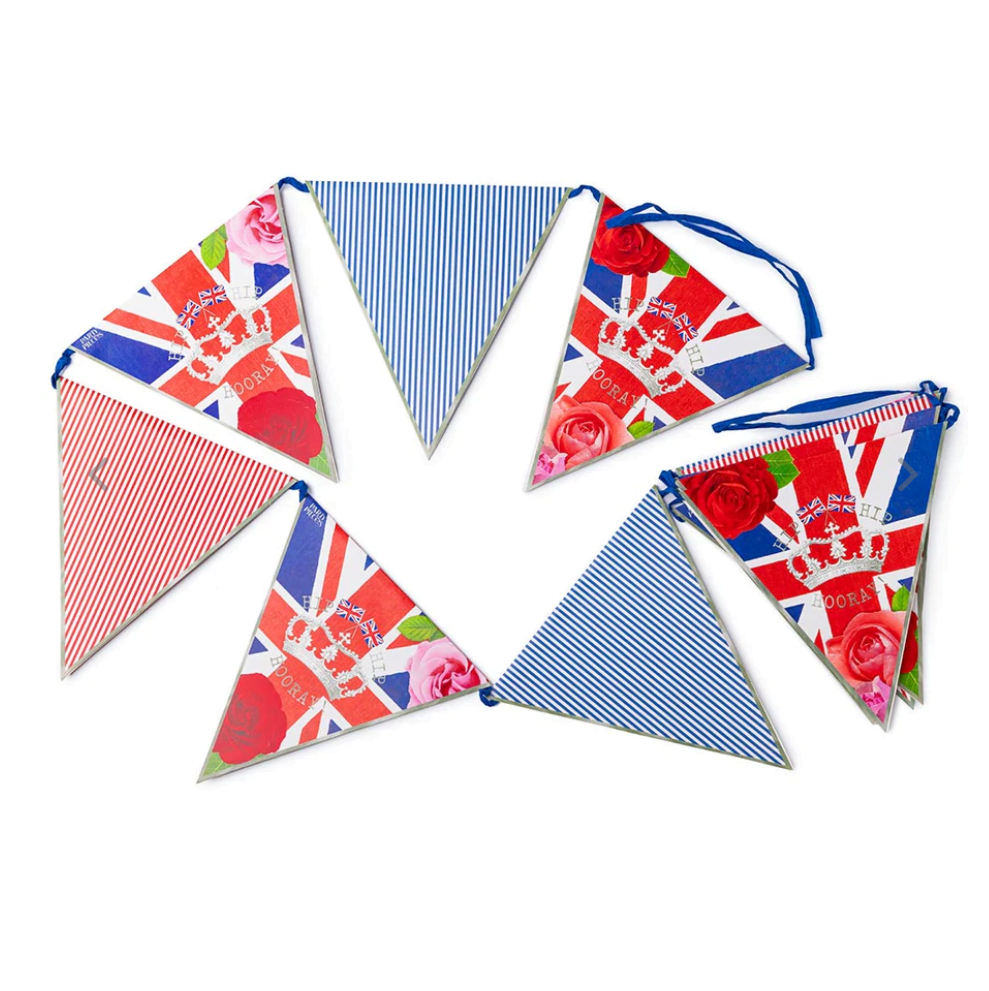

Coronation chicken was invented in 1953 by two Cordon Bleu cooks, Constance Spry and Rosemary Hume, for the coronation of Queen Elizabeth II. It comprises cooked chicken, herbs and spices and a creamy mayonnaise.
In the 1950s Indian spices were not easily obtainable in post-war Britain, so curry powder was used. The dish has evolved to reflect the revolution in British cuisine, and now is made using freshly ground spices, and may also contain other innovations such as flaked almonds, raisins and crème fraîche. Garnish it with chopped coriander – a widely-used ingredient today that was not available in the 1950s.

Image: platinumjubilee.gov.uk
We’ve all been invited to invent a new ‘Platinum pudding’ for this Jubilee. Alternatively, you can nod to earlier royal traditions and provide other dishes with royal connotations: Apple Charlotte (named after Queen Charlotte) or a Victoria sponge (invented after the coronation of Queen Victoria).
Whatever food you’re serving, or alcohol you’re drinking, it is imperative to have plenty of water and soft drinks available throughout the day. Sun, booze and dehydration is never a great combination.
We all hope the Jubilee weekend will be warm and sunny, but this is Britain and we need to be prepared for all contingencies.
How about investing in (or borrowing) some inexpensive pop-up gazebos? Their sidewalls can be lowered or raised and even if the weather is clement they will be useful on the day as food or drink stands, where refreshments can be kept cool, or convenient oases of shade and relaxation (especially for older residents). Remember to festoon the gazebos with festive bunting!
If you’re hosting your own garden party, a gazebo is also useful. Alternatively, plan ahead to take the event inside if the weather turns wet. This means clearing space and tidying up before the party begins.

As with all entertaining, Jubilee events need lots of organising and will be greatly enhanced by showing consideration for everyone involved.
•Plan well ahead – big events will need an organising committee. List all the tasks involved and assign them to individuals who will take responsibility for them.
• Communicate with everyone involved. If you are planning a communal event, announce it well ahead. You can post about it on social media or local WhatsApp groups, and you can reinforce your message by putting up posters around the neighbourhood.
• Issue invitations to communal events – they don’t need to be expensive (a photocopied single sheet will do), but if invitations are posted through everyone’s door you know that everybody has been included, especially older residents who do not use social media. The invitations should be very clear about what is involved: start and end time, activities that will take place, timing of the meal, and any contributions needed.
• If you’re planning your own private party, invite people well ahead of the Jubilee weekend, as there will be a lot of social events going on.
• If you are invited to a private Jubilee party, make sure you RSVP as soon as possible. You may receive subsequent offers at this busy time of year, but once you have committed to an event you are obligated to attend – it’s very rude to cancel and take a better offer.
• If you are holding an event in your garden, warn the neighbours or, better still, invite them. If we’re lucky enough to have a warm Jubilee weekend, be conscious about late-night socialising outside – voices and music carry at night, so be considerate about ending your party at a reasonable time.
• Clear up after your party. For big events you will need to enlist helpers well ahead of the date. But even if you’re hosting a private garden party, do make sure that you pick up all disposable tableware at the end of the day – if you leave plates, cups and napkins lying around, they might find their way into neighbours’ gardens.
Good manners are about the basic courtesies that make everyday transactions more pleasurable, and everyone will find them an asset, both socially and professionally.
But there are further refinements of these fundamental codes of behaviour that will enhance social life. These are the small gestures, which show that you care, that you have taken the trouble to notice and accommodate other people, and done your best to make them feel at ease.
As society has evolved, and become less class-ridden and more democratic, people have rejected the more arcane examples of British manners, which seem increasingly irrelevant to modern life. This is understandable, but there is a risk in doing so that some of the more effective niceties will also be obliterated.
As a general rule, your guests will appreciate signs of forethought and planning, which will indicate that their comfort is important to you, and that you are prepared to make an extra effort to ensure they are enjoying themselves. The only risk is that you will overwhelm your guests with your attention, but this is a much better option than leaving them feeling neglected or forgotten.
We are all aware, for example, of the formal accoutrements that will make a dinner party special – seating plan, table linen, matching crockery and glassware, table decorations, candles, and so on, will all send out signals about the occasion. But even if you are inviting friends round to an informal lunch or supper, there are certain finishing touches that will communicate the care you have taken to make them feel welcome.
If you lay the table before they arrive – it signals that you are looking forward to their company and have planned and prepared ahead for it. Even if you are not going for a fully decorated table, add a little finishing touch – a small posy of flowers or some candlesticks for example – to indicate that this is a special occasion.
Give everyone a napkin, or at least a paper napkin – providing hastily torn-off segments of kitchen towel is fine for a family supper but will indicate you are not paying special attention to your guests.
The days of formal house parties are long gone and forgotten – for many of us having people to stay involves improvisation rather than time-honoured arrangements, and we accommodate our guests in hastily purloined children’s bedrooms or on sofa beds. But, however minimal your guest facilities, you can still show you care.
If you do have a guest room (or even a borrowed bedroom) try and prepare it before your guest arrives – guests who have to stand by while the bed is being made up will feel that they are imposing on the host. If you have to improvise for your guest and provide them with a sofa bed that cannot be made up until the end of the evening, at least have the bed linen, pillows and duvet prepared and ready. It shows that you have planned for their stay and done your best to minimise inconvenience.
If your guest has their own bedroom, add some finishing touches: a vase of flowers on the dressing table, an inviting pile of books on the bedside table, a fresh bar of soap, a radio. This attention to detail will show that you care about your guest’s comfort and are happy that they have come to stay.
It is always better to err on the side of making too much effort rather than too little. This is very apparent in how we dress. Strict dress codes are becoming less common and many social invitations are therefore difficult to interpret. Nevertheless, it is better to dress up rather than down for most social occasions. You may feel overdressed, but you will probably look better turned out and smarter than more casually dressed guests and there is the added bonus that the host will see that you have taken some trouble and will appreciate it. By making a bit of an effort you are paying a compliment to your host, and what could be politer than that?
‘Appropriate’ is a term that is frequently bandied about when talking about behaviour. Clearly, there is a time and a place for (nearly) everything and if we are going to be civilised members of society the supposition is that we will recognise this.
From earliest childhood, we are taught what is ‘appropriate’: we must not talk or laugh during school assembly or church services, although it is fine to do so in the playground; we must not run around in restaurants, disturbing the other diners, although it is quite acceptable to do so at an open-air picnic. We learn the simple fact is that our demeanour must be adjusted according to the circumstances in which we find ourselves. We also learn at a very young age that how we behave at home, or with our immediate family, is different from the ways in which we conduct ourselves in the world – for example at school, or when visiting our friends’ families. Recognising that behaviour must be adapted and moderated according to the situation we are in is a vital part of growing up.
As adults, it would seem, therefore, that we should be well schooled in recognising places that demand discretion and restraint. This would certainly be the case in locations where important business is being conducted – courtrooms, chambers of government, places of worship – and by modifying our behaviour we demonstrate that we respect the work that is being done in these spaces.
We must also assess whether our behaviour is likely to impact negatively on other people. If we are acting inappropriately in a public space, the people around us might see our behaviour as offensive or disrespectful. Recognising this means acknowledging that whenever we are out in the world we are observed by other people. We do not exist in a hermetic bubble where we can behave as we choose; being seen in society means making continual minute adjustments to our public persona and ensuring that we are never transgressing against the people who surround us.
From 6 April new UK legislation has introduced no-fault divorce. This is aimed at reducing recriminations and conflict, completely removing the necessity for divorcing couples to apportion blame for the breakdown of their marriage.
These ground-breaking reforms are undoubtedly welcome news for couples who are contemplating divorce. Nevertheless, however enlightened divorce law may now be, it still cannot completely alleviate the pain and trauma of divorce. While grievances need not be aired in legal proceedings, they may still be very real, and many couples will experience difficulties when communicating the news and dealing with their immediate family and wider circle of friends. These recommendations will help you break the news of divorce and will give you some advice about navigating social situations in the immediate aftermath.
It’s essential to tell friends and family when you’re getting divorced, but be careful. Many couples are serial divorce-planners; they talk incessantly about how it’s all over, they reveal detailed plans for separation, they elicit sympathy. And then, within weeks, they’re back together again. Understandably, onlookers find this behaviour intensely irritating, and their sympathy diminishes exponentially.
So don’t announce an imminent divorce until you’re absolutely sure this is your final decision. Once you know this is irreversible, tell your friends and family about your plans. It is also helpful (and easier for you) if you can clarify how you intend to behave around your ex-partner. If you are filled with rage, bitterness and resentment, it is a safe assumption that ‘civilised’ socialising is a distant prospect. If you have children, you may be determined to behave as well as possible, trying hard to keep your anger in check, and maintaining a veneer of normality. You may be divorcing quite amicably, with no intention of losing contact.
Once these issues have been clarified, people will have a better idea about how they should behave:
•Be discreet when communicating with other people. Reserve your most bitter regrets, recriminations and revelations for your counsellor, lawyer or best friend.
•Don’t belabour casual acquaintances with the sins of your ex-partner. You will be seen as a bore.
•In public, at least, try and remain positive about your ex-partner.
•Let people know if you think they’re rushing you into mutual socialising. If you don’t want to be confronted by your ex across a table at a dinner party, then explicitly tell your friends that you find it difficult.
•When you’re ready to start looking again, tell your friends. If they’re frantic to match-make, and you just can’t face it, tell them explicitly. You shouldn’t feel railroaded into dating when you’re not ready.
•Be absolutely discreet about confidences. If you’re talking to both ex-partners, and revealing private confidences to each, you may find yourself entangled in some very fraught emotional territory. You will be seen as colluding, provocative and trouble-stirring – it’s far better to respect confidences.
•If you’re friendly with the divorcing couple, try to be sympathetic and supportive without being totally partisan. Post-divorce revelations are highly charged and emotional, and you may not be getting the whole story.
•Be certain about where your loyalties lie. If you’re a close friend of one half of a bitterly divorcing couple, you may be seen as disloyal if you try and maintain relations with the estranged partner. Be honest and open about everything you do and you won’t get trapped in game-playing.
•Don’t greet news of a divorce with remarks like “I never liked him/her anyway”. You will be devaluing the marriage, and bringing your divorcing friend’s judgement into question at a time when they’re feeling raw and vulnerable. You will also be revealing that you were two-faced – pretending to like someone you detested.
• In situations where there is potential conflict – perhaps you are hosting a party, and feel that you can only safely invite one of the ex-partners – be completely up-front about your actions, explaining your motives to both parties.
•Make yourself endlessly available to your divorcing friend. Give him/her as much of your time as possible, and always be ready to take that midnight call or accept an impromptu visit.
•When your friend is ready to move on, do your best to ease him/her back in society. Invite him/her to meet new friends at a dinner party; or even try your hand at a little matchmaking. Above all, take it slowly…